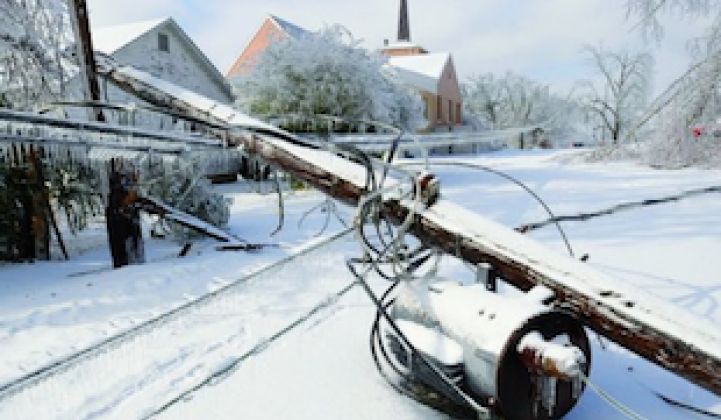With heavy snows expected to blanket the Northeast this weekend, electric power providers are preparing to bounce back as quickly as possible from any blizzard-related outages.
In the wake of Hurricane Sandy, resilience in the face of extreme weather has also been a key concern for policymakers. Last week, the Senate approved a $50 billion Sandy relief package that will make transit systems, the electric grid and other infrastructure more resilient during storms. A week earlier, a Senate resolution urged Congress to “prepare and protect communities from extreme weather, sea-level rise, drought, flooding, wildfire, and other changing conditions exacerbated by carbon pollution.”
Electric utilities will be deeply involved in any effort to create more resilient infrastructure. Their assets -- power plants, transmission lines and so forth -- not only contribute to the risks associated with climate change, including extreme weather, but also are vulnerable to those same risks.
These aren’t remote, abstract risks -- for utilities or for society. Hurricane Sandy threw millions of people into darkness, for weeks, in some cases, and required a national response to get the grid up and running. During the 2011 drought, Texas barely kept the lights on; this summer, it might not be so lucky.
How are utilities responding to the resiliency challenge? The Wall Street Journal reports that New York and New Jersey utilities’ post-Sandy efforts emphasize strengthening and expanding transmission lines and improving disaster communications. Con Ed pledged $250 million toward storm protection measures and is exploring investments totaling $1 billion.
Texas is considering making changes to its electricity market, but that’s only partly driven by an awareness of how drought can cripple electricity generation. Fearing a capacity shortage, Texas has un-mothballed over 2,000 megawatts of gas-fired generation and may expand its demand response programs, which pay customers to reduce or shift electricity use during peak times. However, Texas doesn’t appear to be seriously considering a major ramp-up of energy efficiency as the least risky, least expensive, and least polluting strategy for meeting Texas’s electricity needs.
After Hurricane Katrina, Louisiana-based Entergy partnered with reinsurer Swiss Re on an in-depth study examining how climate and extreme weather could affect the utility and the entire Gulf region. While the results are sobering -- $350 billion or more in projected losses by 2030 -- they’re also actionable: the report identifies $120 billion of resilience-building investments that substantially reduce the risk of future losses. Some of these measures, like protecting and rebuilding wetlands (which guard against storm surges), go beyond a utility’s traditional purview.
These distinct efforts raise the question of what exactly defines resiliency. A resilient electricity system is durable and adaptable; it holds up over time despite changing, and even extreme, conditions. It’s also restorative: it curtails or eliminates outages in the short term, and reduces extreme weather risks over the long term. Low-carbon, modular resources like distributed solar PV and energy efficiency have a special role in making our grid -- and our society -- more resilient.
The U.S. electricity industry has begun a massive capital investment cycle at a time of great uncertainty about how policy, technology and demographic trends could impact utilities over the long term. Utility investments can have useful lives of 30 to 40 years, or even longer. Determining a course of action or a coherent investment strategy amid the many variables here is no small task.
Despite these challenges, some guiding principles could help utilities and regulators build a smart, resilient electricity grid.
Take the long view. Utility CEOs and regulators need to demonstrate the value proposition of low-carbon, resilience-building investments to the public so that opposition to short-term rate increases doesn’t undermine thoughtful investments designed to save consumers billions. Even the most sensible investments will face an uphill battle if regulators, politicians and stakeholders don’t see the value in spending a little more now to reduce the risk of spending a lot more later.
Engage and educate stakeholders. Utilities as diverse as Arizona Public Service, National Grid and the Tennessee Valley Authority have credited robust stakeholder engagement with helping to build shared understanding and support for utility initiatives. Entergy has spent more than two years on the road with its Swiss Re report, working with local communities to identify long-term risks and appropriate responses.
Focus on managing risk. Minimizing the risk of utility investments is an agenda that stakeholders of all stripes can get behind. All parties will be best served if utility regulators oversee a process that puts all options on the table and allows robust analysis and probability to guide decision-making.
The controversy that sometimes surrounds energy choices can obscure a simple fact: Some choices are more exposed to risk, while others are less exposed. When the next storm strikes -- and it will -- a more resilient grid will shore up communities and protect our economy.
***
Dan Mullen is the Senior Manager for Electric Power Programs at Ceres, an organization that mobilizes investor and business leadership to build a thriving, sustainable global economy. Mullen works to identify and advance solutions that will transform the U.S. electric utility industry in line with the urgent goal of sustainably meeting society’s 21st-century energy needs.



